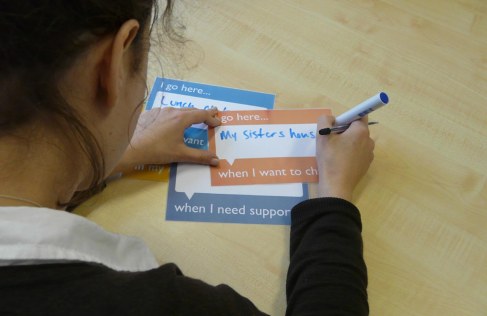![]() “Don’t talk to strangers.” It’s a message that many of us learn in our early childhood, and one which is often carried through into adulthood as we move from A to B, minding our own business at the bus stop or in the park. Yet on a recent visit to Rutherglen in South Lanarkshire, the purpose was to do exactly the opposite.
“Don’t talk to strangers.” It’s a message that many of us learn in our early childhood, and one which is often carried through into adulthood as we move from A to B, minding our own business at the bus stop or in the park. Yet on a recent visit to Rutherglen in South Lanarkshire, the purpose was to do exactly the opposite.
As part of the Better by Design programme, we are working with Healthy n Happy (a Community Development Trust) to undertake five days of community-based research. Healthy n Happy’s identity and ethos is rooted in the fact that it is a community-owned organisation, steered and governed by local people; their wide range of projects and activities are coordinated and delivered by a strong team of local volunteers and staff.
The purpose of our research was to speak to individuals who may not already be using or aware of the organisation, listening to their thoughts about the local area and finding out about the assets and needs of their community as defined by the people who live there. Whilst these conversations provide only a brief snapshot of the community, this approach can also be integrated with the ongoing activities and outreach already taking place in neighbourhoods, providing simple opportunities for individuals to contribute to a longer-term discussion about what’s important in their area.
Conversations took place on the street and in public spaces such as shops, libraries, the health centre, cafés and parks. Simple visual prompts (described below) were used to start conversations and to make it easy for individuals to contribute, no matter how much or little time they had to spare.
Maps. For quick conversations on the street, we approached people with a map of the area and asked them to pinpoint something that they like or that is useful, speaking to them about why they’d chosen these things. The maps included prompts such as ‘Where are the places and spaces that you go to?’, ‘Which clubs and organisations meet locally?’ and ‘What other things are important to you?’
‘Where do you go when…?’ Where there was opportunity for a longer conversation, we used prompt cards inspired by the artist Candy Chang’s ‘Neighborland’ project. These simple cards are used as colourful invitations for people to tell us where they would go in different situations, such as when they want to chat, relax, seek support or have fun. Some people wrote their suggestions down, others preferred a verbal discussion.
The Place Game. During a visit to a volunteers’ training morning, we used a board game to facilitate a group discussion about the local area. During the game, participants roll a dice then pick up a corresponding card, which invites them to share tips and insider knowledge about the place where they live, e.g. ‘Ask the group to think of shops where you can buy food that is local’, ‘Think of 3 places where you go when you want to have a laugh’ or ‘Ask someone to tell you an interesting fact about Rutherglen or Cambuslang’.
What next?
Asset mapping is a form of asset-based community development that focuses on the capacities, resources and networks that exist in an area, rather than assessing a place based on its deficiencies. Based on the conversations held over two days, we began to create an asset map for the area. In this case, the asset map functions as both a record of the physical places and organisations that were significant to the people we spoke to, and a representation of other stories and insights that were shared.
Built up over time, an asset map can be used to:
- Identify topics that are significant locally (e.g. the availability of affordable food or the use of green spaces)
- Find out about small projects or initiatives that are not widely known
- Identify opportunities for collaboration and connection between different networks and resources
As a visitor, talking to strangers can quickly gather many thought-provoking insights into an area. It can also kick-start ongoing discussions between those based in the area. Ultimately, this approach is at its most valuable when it is owned and directed by local people; integrating simple research methods into local activities and outreach work can provide a starting point for new connections, meaningful conversations and longer-term planning.



Louise This is looking really interesting. Is there a report anywhere? Many thanks